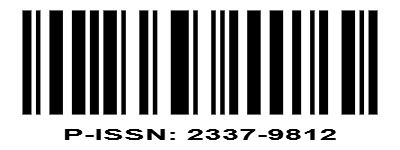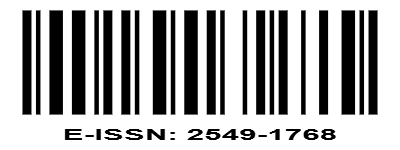FORMULATION AND PHYSICAL STABILITY TESTING OF CREAM SCRUB PREPARATIONS FROM ETHANOL EXTRACT OF Nelumbo nucifera GAERTN FLOWER AND LEAF
DOI:
https://doi.org/10.22373/biotik.v12i1.22952Keywords:
Cream Scrub, Flower, Leaf, Nelumbo nuciferaAbstract
Nelumbo nucifera is an aquatic plant that thrives in muddy and soggy soil, particularly in swampy environments. Nelumbo nucifera is utilized in traditional medicine for various purposes, including the management of diarrhea, tissue inflammation, and homeostasis. The flowers and leaves of Nelumbo nucifera contain many secondary metabolite chemicals, including flavonoids, alkaloids, tannins, and antioxidants. The objective of this study is to ascertain the feasibility of formulating a cream scrub using the ethanol extract of Nelumbo nucifera flowers and leaves. Additionally, the study attempts to discover if concentrations of 3%, 5%, and 7% of this extract can effectively moisturize the skin. This research technique is based on experimentation, involving the creation of simplicia, the production of extracts, the formulation of body scrub preparations using ethanol extracts of Nelumbo nucifera flowers and leaves, and the subsequent evaluation of these body scrub preparations. This study found that the moisture content of Nelumbo nucifera flower ethanol extract cream increased by 41.2% in F1, 46.5% in F2, and 52.9% in F3. The humidity percentage values for Nelumbo nucifera leaf extract cream were obtained as follows: F1 at 38.8%, F2 at 44.4%, and F3 at 47.7%. The ethanol extract derived from the flowers and leaves of Nelumbo nucifera can be prepared and used as a cream scrub. A cream scrub containing Nelumbo nucifera flower and leaf extract at concentrations of 3%, 5%, and 7% can effectively moisturize the skin.
Downloads
References
. Skowron, K., Bauza-Kaszewska, J., Kraszewska, Z., Wiktorczyk-Kapischke, N., Grudlewska-Buda, K., Kwiecińska-Piróg, J., ... & Gospodarek-Komkowska, E. (2021). Human skin microbiome: impact of intrinsic and extrinsic factors on skin microbiota. Microorganisms, 9(3), 543.
. Pourzand, C., Albieri-Borges, A., & Raczek, N. N. (2022). Shedding a new light on skin aging, iron-and redox-homeostasis and emerging natural antioxidants. Antioxidants, 11(3), 471.
. Ugoeze, K. C., & Odeku, O. A. (2022). Herbal bioactive–based cosmetics. In Herbal Bioactive-Based Drug Delivery Systems (pp. 195-226). Academic Press.
. Srinivasulu, M., Chandra, M. S., Gooty, J. M., & Madhavi, A. (2022). Personal care products—fragrances, cosmetics, and sunscreens—in the environment. In Environmental Micropollutants (pp. 131-149). Elsevier.
. Liu, J. K. (2022). Natural products in cosmetics. Natural products and bioprospecting, 12(1), 40.
. Salem, Y., Rajha, H. N., Sunoqrot, S., Hammad, A. M., Castangia, I., Manconi, M., ... & Louka, N. (2023). Exhausted Grape Seed Residues as a Valuable Source of Antioxidant Molecules for the Formulation of Biocompatible Cosmetic Scrubs. Molecules, 28(13), 5049.
. Khabiya, K., & Somani, S. A Review on Skin, Skin Cosmetic and Relative Herbal Ingredients.
. Gebashe, F. C., Naidoo, D., Amoo, S. O., & Masondo, N. A. (2022). Cosmeceuticals: a newly expanding industry in South Africa. Cosmetics, 9(4), 77.
. On-Nom, N., Thangsiri, S., Inthachat, W., Temviriyanukul, P., Sahasakul, Y., Chupeerach, C., ... & Suttisansanee, U. (2023). Seasonal effects on phenolic contents and in vitro health-promoting bioactivities of sacred lotus (Nelumbo nucifera). Plants, 12(7), 1441.
. Jiang, H., Chen, J., Liu, G., Zhou, P., Jin, Q., Wang, Y., ... & Xu, Y. (2023). Screening of early flowering lotus (Nelumbo nucifera Gaertn.) cultivars and effects of different cultivars on flowering period. Plants, 12(8), 1683.
. Sranujit, R. P., Noysang, C., Tippayawat, P., Kooltheat, N., Luetragoon, T., & Usuwanthim, K. (2021). Phytochemicals and immunomodulatory effect of Nelumbo nucifera flower extracts on human macrophages. Plants, 10(10), 2007.
. Fitri, K., Khairani, T. N., Andry, M., Rizka, N., & Nasution, M. A. (2023). UJI Aktivitas Krim Anti Jerawat Ekstrak Etanol Daun Seroja (Nelumbo Nucifera G.) Terhadap Bakteri Propionibacterium acnes dan Staphylococcus aureus. Journal of Pharmaceutical and Sciences, 37-45.
. Setiawan, B., Fika, R., Fadhila, M., Trisna, M., & Putri, L. A. (2023). Effect of Different Concentrations of Propylene Glycol and Glycerin on the Formulation of Guava Leaf (Psidium Guajava Linn.) Body Scrub with White Rice (Oryza sativa Linn.). Jurnal eduhealth, 14(03), 1332-1336.
. Pokhrel, T., Shrestha, D., Dhakal, K., Yadav, P. M., & Adhikari, A. (2022). Comparative Analysis of the Antioxidant and Antidiabetic Potential of Nelumbo nucifera Gaertn. and Nymphaea lotus L. var. pubescens (Willd.). Journal of Chemistry, 2022.
. Hasibuan, P. A. Z., Sumaiyah, S., & Siregar, D. H. (2022). Formulation and Evaluation of Body Scrub Cream Containing Ethanol Extract of Black Cumin Seeds (Nigella sativa L.) and Coffee Grounds (Coffea arabica L.) as Anti-aging. Indonesian Journal of Pharmaceutical and Clinical Research, 5(2), 09-17.
. Tonapa, M. I., Pratiwi, R. D., & Gunawan, E. (2021). Formulation And Stability Test Of Lip Cream Preparation Of Kenop Flower Ethanol Extract (Gomphrena Globosa L.). Journal Of Pharmacological Research And Developments, 3(2).
. Khairani, T. N., Fitri, K., Andry, M., & Nasution, M. A. (2023). Antibacterial Activity of Basil Leaves Extract Towards Bacteria Staphylococcus aureus and Staphylococcus epidermidis in Deodorant Spray. Jurnal Farmasi Sains Dan Praktis, 252-260.
. Dalimunthe, G. I., Nasution, H. M., & Nasution, M. A. (2024). Formulasi dan Uji Aktivitas Antibakteri Sediaan Ekstrak Salep Ubi Jalar Ungu (Ipomoea Batatas (L.)) Lamk terhadap Bakteri Staphylococcus Aureus pada Penyembuhan Penyakit Luka Bernanah. FARMASAINKES: JURNAL FARMASI, SAINS, dan KESEHATAN, 3(2), 205-222.
. Faisal, H., Sastra, H., Andry, M., Sari, M., Chan, A., & Nasution, M. A. (2023). Formulasi sediaan pasta gigi ekstrak etanol buah takokak (Solanum torvum Sw.) dan tulang ikan tuna sirip kuning (Thunnus albacares) terhadap bakteri Streptococcus viridans dan bakteri Escherichia coli. Journal of Pharmaceutical and Sciences, 1322-1338.
. Khairani, T. N., Fitri, K., Andry, M., & Nasution, M. A. (2023). Antibacterial Activity of Basil Leaves Extract Towards Bacteria Staphylococcus aureus and Staphylococcus epidermidis in Deodorant Spray. Jurnal Farmasi Sains Dan Praktis, 252-260.
. Leny, L., Diana, V. E., Ginting, M., Iskandar, B., & Fadhila, C. (2022). The Effectiveness of Pandan Wangi Leaves (Pandanus Amaryllifolius Roxb.) Body Scrub Formulation in Smoothing the Skin. Asian Journal of Pharmaceutical Research and Development, 10(1), 1-5.
. Leny, L., Fitri, K., Lase, Y. K., Hafiz, I., & Iskandar, B. (2022). Formulation of Hair Tonic from Ethanol Extract of Sea Hibiscus (Hibiscus tileaceus L.) Leaves in Promoting Hair Growth on Guinea Pig (Cavia porcellus). Journal of Drug Delivery and Therapeutics, 12(2), 1-5.
. Khabiya, K., & Somani, S. A Review on Skin, Skin Cosmetic and Relative Herbal Ingredients.
. Sopianti, D. S., & Munawara, L. (2022). VARIASI EKSTRAK DAUN JAMBU BIJI MERAH (Psidium guajava L.) PADA LULUR BODY SCRUB. Oceana Biomedicina Journal, 5(2), 119-131.
. Pise, S., Shaikh, F., & Vohra, P. (2023). Formulation and evaluation of herbal anti-acne face scrub. Research Journal of Topical and Cosmetic Sciences, 14(2), 53-57.
. Kulawik-Pióro, A., & Goździcka, W. J. (2022). Plant and herbal extracts as ingredients of topical agents in the prevention and treatment radiodermatitis: a systematic literature review. Cosmetics, 9(3), 63.
. Chen, L., Chang, X., Wang, H., Chen, J., & Zhu, Y. (2022). Stretchable and transparent multimodal electronic-skin sensors in detecting strain, temperature, and humidity. Nano Energy, 96, 107077.
Downloads
Published
Issue
Section
License
Authors who publish with BIOTIK: Jurnal Ilmiah Biologi Teknologi dan Kependidikan agree to the following terms:
- Authors retain copyright and grant the journal right of first publication with the work simultaneously licensed under a Creative Commons Attribution License that allows others to share the work with an acknowledgement of the work's authorship and initial publication in this journal.
- Authors are able to enter into separate, additional contractual arrangements for the non-exclusive distribution of the journal's published version of the work (e.g., post it to an institutional repository or publish it in a book), with an acknowledgement of its initial publication in this journal.
- Authors are permitted and encouraged to post their work online (e.g., in institutional repositories or on their website) prior to and during the submission process, as it can lead to productive exchanges, as well as earlier and greater citation of published work.











